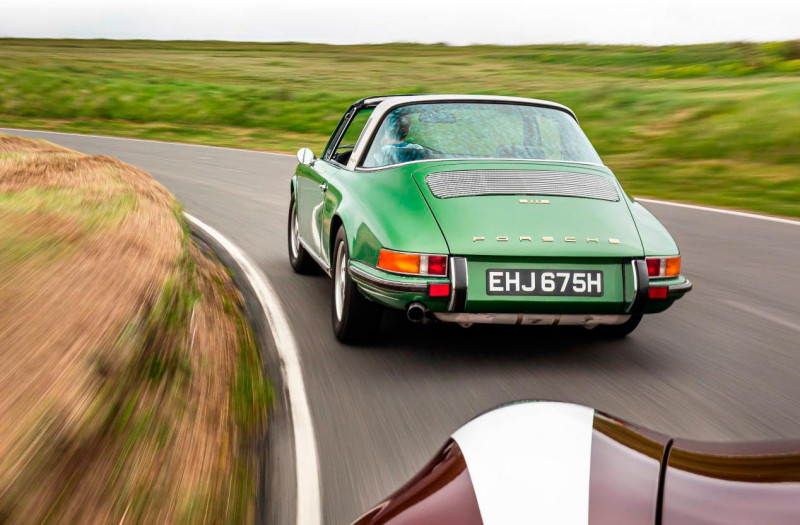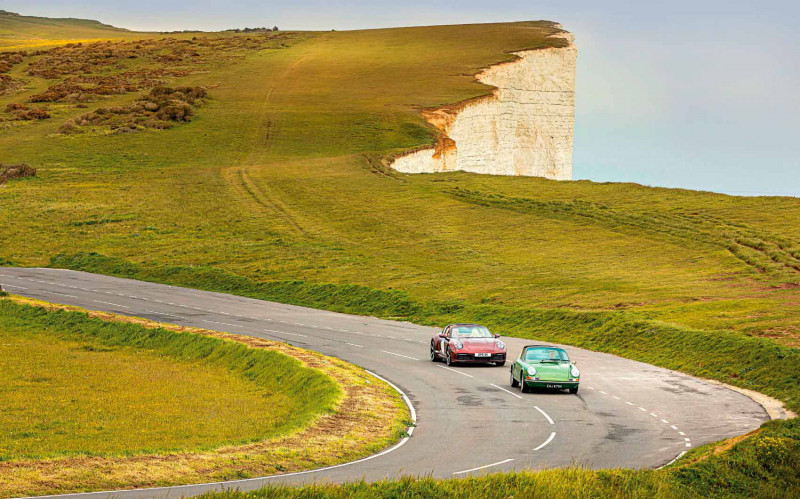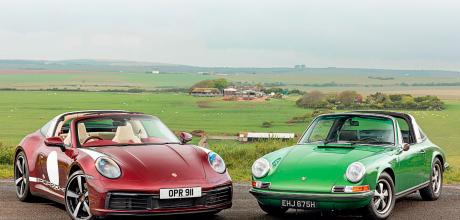1970 Porsche 911 Targa vs. 2021 911 Targa 992 Heritage Design Edition
Targas on tour We assess the merits of Porsche Exclusive’s Heritage Design Edition 992 Targa by pitting it against an early roll bar example. Total 911 brings together two sun-seeking 911s exactly half a century apart as the new 992 Targa Heritage Edition seeks to pay homage to its roll-hooped forefathers. Written by Lee Sibley. Photography by Daniel Pullen.
A Tale of Two Targas 1970 v 2021 Porsche Targas
First drive in Exclusive’s Heritage Design Edition Targa, alongside its 50-year-old forefather
Of all the things Porsche is universally revered for, perhaps the greatest success story for the company is the longevity of its engineering and designs. Porsche’s entire design philosophy is shaped around the 911 which, in particular, has triumphed over adversity for nearly 60 years with its engine in the back, its unique layout and design remaining staunchly loyal to Butzi’s original masterpiece.

By way of enduring technology, we need only consider the likes of the ducktail as an aerodynamic aid, turbocharging (specifically VTG), or twin-clutch automatic gearboxes, all of which have, over the years, become established ingredients of the Neunelfer’s repertoire. History tells us that once they are introduced onto the 911, Porsche’s new technologies and design principles tend to be everlasting.
The only chapter of 911 narrative which seems to abandon that theory is the Targa. Revealed in 1966 as a ‘Safety Cabriolet’, the Targa was a revolutionary solution to a requirement for an open-topped 911, even if it was a compromise on grounds of structural rigidity and an anticipated legislation change over a conventional Cabriolet design.
Nevertheless, the Targa would endure with its roll bar design from production in 1967 – even after the 911 Cabriolet was eventually sanctioned in SC form in 1983 – right through to the early 1990s, by which time it was firmly recognised as a 25-year-old mainstay of the 911 lineup. But then things changed: Porsche went back to the drawing board and completely redesigned its Targa for the 993. Only with the advent of the first water-cooled 996 generation has Porsche otherwise started afresh with the design of an established 911 model, in nearly 60 years of the car’s existence.
A large, retractable glass roof allowed plenty of sunlight and fresh air motoring for the 993 Targa, all the while retaining a 911 silhouette which was vaguely similar to its Coupe sister.

This logical approach to the 911 Targa would itself remain in production for nearly two decades, until the turn of the 991.1 Targa in 2014 – by which point, Porsche was once again looking backwards in order to go magnificently forwards.
Porsche revived the Targa’s classic roll bar look to spectacular acclaim, a move which well and truly reignited the popularity of not just contemporary Targas but those of a classic variety too. The Targas both old and new have once again proved to be hot property among enthusiasts, with used examples comfortably fetching more than a Cabriolet equivalent. This is especially true of 991.1 and 991.2-generation Targas: you’ll pay top money for one, if indeed you can find one on the market which hangs around long enough to grab your interest.
It came as no surprise when in 2020 Porsche announced it would bring forward the 991.2’s roof system with its show-stopping kinetics onto the 992 Targa. Perhaps the perfect blend of classic design beautifully instilled within a contemporary framework, the 992 Targa had it all – and that was before Porsche announced the special edition resplendent in our pictures.
We’ll admit to being more than a little dubious when Porsche unveiled the 992 Targa Heritage Design Edition in June 2020, given the Exclusive department’s recent form in turning out “special” new models. The likes of the Exclusive GB Edition 991.1 Turbo S are viewed as standard production cars with mere ‘trinkets’ added to them, which is a long way from the ground-up masterpieces of the department’s recent past such as the 997 Sport Classic and Speedster.
However, the Targa Heritage Edition clearly represents something of a return to form, engineers having consulted the company’s history books to serve a respectful revival of past designs and trends for its modern 911. Cherry red paintwork is said to be akin to a 356 colour from the 1950s, and a ‘Heritage’ decklid badge evokes those given to Porsche 356s with engines that had covered more than 100,000 kilometres (perhaps the concept of this badge of honour should be revived for modern GT cars too?).
Otherwise there’s plenty of historical 911 referencing via the early Porsche crest on the steering wheel, outside centre caps, and of course the Targa’s nose, while its interior has been expertly appointed with corduroy and perforated Alcantara alongside rich OLEA leather. Green numbering and a white pointer can be found on the tachometer, with green lettering across the 992’s two driver display screens, these harking back to the very earliest 911s; a gold plaque with retro ‘911’ lettering signifies its allocation number of the 992 units produced for worldwide markets. The whole package is expertly appointed overall, though the jury’s still out on the lollipop and spear exterior decals, which looks a little juvenile on an otherwise very grown-up car.
One of four such projects to hail from the Exclusive department over the next four years (our money’s on a Sport Classic in 2021, a ‘50 years of RS’ special in 2022, and 60th Anniversary 911 in 2023), the Targa Heritage Edition has, on paper at least, got the concept off to an extremely positive start.
But, to celebrate heritage, first you must have history, and Porsche has plenty of it – which is why we’ve arranged for a unique long-bonnet Targa to join our 992 HDE for a seaside cruise.
Owned by Paragon Porsche’s Mark Sumpter, that it’s a 1970 year Targa means there are fully 50 years between these two open-topped 911s, though the lineage between them is clear. Silver roll bars and glass wraparound rear screens can be found aft of the front seats, plus there’s gold badging and ‘five leaf ’ wheel designs from Fuchs shared between these two pretty Porsches.
Roofs stowed, there’s blatant homogeny to their silhouettes, even if the 992’s has been gently massaged to offer a more streamlined and aerodynamically efficient solution. Yet somehow, it is the smaller, more dainty C-series Targa which arguably sits prettier from absolutely any angle you care to look at it, whereas the 992 can look lumpy and fussy from certain positions.
As snapper Dan’s pictures will attest to, these two descendants of the Targa bloodline aren’t identical from the inside. As a 1970 911, Mark’s Targa came three years after Porsche switched its green dials and white pointers to white numbering with red pointers, while perforated Alcantara was also ditched by the turn of the C program. Corduroy seats were still present in the 911 lineup, but Mark has had the seats swapped out for Recaro Sports items retrimmed with houndstooth centres. Lateral hold afforded from those tight-hugging seats will come in handy later.
As the midday sun reaches its highest point in the sky, Dan packs his cameras away while Mark and I head out for a spirited coffee run, our destination a beachside cafe around 20 minutes away. The 992’s flat six bursts into life with almost clinical immediacy, whereas the long-bonnet Targa gives us a little more theatre first: chattering away as the engine cranks over, followed by a bassy thrum as the flat six catches, its pitch wavering as Mark adjusts the throttle lever between the front seats to get a nice-running idle.
The B-roads taking us to our café stop are bumpy and winding, though the 992 tackles the route without breaking a sweat. Enthusiasts may generally seek the nat-asp flat six of the 991.1 over a 991.2 or even 992, but there’s no question turbochargers suit the bulky Targa, making light work in propelling its 1,675kg mass along the asphalt. Its portly weight isn’t an issue when it comes to velocity (though this is a lifestyle rather than a performance 911), though I’m certain it affects its ride quality. That’s because over slow and medium-speed bumps, the 992 Targa is just too crashy, particularly for a lifestyle model that is designed for cruising about town. I found the current Turbo S Cabriolet had the same problem, this being another heavy, open-topped 992.
Otherwise, the 992 is technically faultless. The directness of its turn-in is a particular highlight, and I’m adamant Porsche has tweaked its Porsche Exhaust offering for these latest 992s, as the 2020 Model Year 911s appear to carry a louder resonance in Sport mode than previous 992 model years – even with the roof up.
Enshrined in a combination of corduroy and the finest quality leather, with iconic green dials ahead of me, there’s no question this feels like a very special place to be, though the ‘Porsche Exclusiv Manufaktur’ logo on the central arm rest and brushed alloy door guards with ‘Targa 4S Heritage Design Edition’ will do justice to remind when needed. There’s a practical advantage to the corduroy seat centres too, as it means I won’t have to peel my sweaty back off a leather throne after an afternoon of top-down driving (if you’ve an open-topped 911, you’ll empathise!), though there are durability concerns for the material, which already appears to be wearing a blue colouring on the seat base, likely from jeans.
Flicking between gears two, three and four of the eight-speed PDK gearbox, the 992 proves good fun for our run down to the sea, though I’m excited to drive Mark’s long bonnet on the other side of a coffee. Though it appears stock, sitting elegantly on six-inch wide Fuchs all round, a subtle drop in ride height by around 20 millimetres gives a subtle indication this C-series Targa has undergone some revisions. Originally a 2.2E, the flat six out back retains its factory green fan shroud – indicative of ‘E’ models in the long-bonnet era – but has been upgraded to RS-spec, albeit with 911S cams. The result is around 200bhp (up from 155bhp), which is ten less than a 2.7 RS, but Mark says it’ll deliver more torque. 911S-spec brakes have been fitted, and RS-spec anti-roll bars have been introduced along both axles, to help with fast cornering. A classic Q-car then, and even better that it’s delivered with the appeal of fresh-air motoring, Mark having folded and stowed the Targa’s fabric roof under the front boot.
Whereas the 992 is completely effortless to drive, this early Targa requires thought: it’s a 901 gearbox with dogleg first gear for a start, so I need to recalibrate the shift pattern in my head, and while it proves to be possibly the finest example of Porsche’s early five-speed transmission I’ve driven, it still requires a bit of technique to execute a clean shift through the gate each time.
Then there’s turn-in: if the immediacy of the 992’s nose to respond to inputs at the wheel is akin to an email sent via fibre optic, the classic’s response time is comparable to receiving a letter in the post. The delay is huge! It means I have to turn the wheel much, much earlier than in the 992 to allow the early Targa’s nose to begin its slower directional changes. Indeed, the very beauty of piloting a classic 911 lies within the nuances of its drive. The Targa’s weight transfer almost feels exaggerated compared to the stiff 992, but it’s letting you know, letting you feel, intrinsically, where the grip is at all times. Throwing the Targa into a second gear corner at speed, there’s a good deal of body roll, and you can feel that weight transfer to the far side tyres, balancing the throttle and steering accordingly through the turn to maintain speed but keep grip. Then, with a gentle unwind of steering and gradual press of the gas pedal, the Targa shoots forward with surprising gusto, particularly in its mid-range, that surge of torque Mark mentioned now very evident. third gear is called upon, and I look down at the speedo while swapping cogs. Nearly 50mph right after a corner! Who said these classic cars were slow?!
The 992’s appeal lies in its detail, whereas the long bonnet’s charm is in its drive. We elect to go the very long way back to base from our beachside café, and the next hour is spent playing with the classic Targa’s breathy engine and altogether more simple chassis. Great fun is had weighting the nose up and dialing it into the apex, and then laughing hysterically on the other side of a corner as the Targa’s torque thrusts its nose skywards again under full chat.
It has a standard exhaust fitted so there’s no ostentatious popping and banging, just the beautiful timbres of a flat six working hard behind me as I try, in vain, to keep pace with Mark, who’s putting some heat into the 992’s Pirellis. I’m content with not competing: at my own pace and under the warmth of that big fireball in the sky, this C-series Targa has to be close to classic 911 nirvana.
And that’s where we’ll leave you: two stunning Porsche 911s, exactly half a century apart, bombing through the South Downs countryside, their silver roll hoops glistening in the summer sun while daylight fills each cabin, illuminating the grinning faces of each driver within. A tale of two Targas indeed.
FAR RIGHT Dash-mounted model designation is another nod to the long-bonnet era, here displaying its limited production build number BELOW RIGHT 992’s green numbering with white pointer is a glorious throwback to the 356 and early 911 lineage.
ABOVE Separated by fully half a century, the first and latest rollhooped 911s are unmistakeable in their Targa design philosophy. RIGHT Originally a 2.2E, this C-series Targa has been upgraded to 2.7-litres, retaining its Bosch MFI.
BELOW An early 911 has plenty of charm through simplicity, with a larger diameter wheel and higher driving position. Targa top is stowed manually.
“To celebrate heritage, first you must have history, and Porsche has plenty of it”


